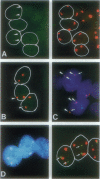Abstract
Intracystic papillary breast tumors, including intraductal papilloma and low-grade intracystic papillary carcinoma, constitute a group for which differential diagnosis is frequently difficult. We examined the status of chromosomes 16 and 1 by multicolor fluorescence in situ hybridization (FISH) analyses and the DNA ploidy patterns by flow cytometry in 26 intracystic papillary tumors. Alterations of chromosomes 16 and 1 were detected by FISH in 93 and 85%, respectively, of 14 low-grade papillary carcinomas, and the latter alterations always concurred with the former. Two-color FISH using probes for the D1Z1 (1q12) and D16Z2 (16cen) loci or the D1Z1 and D16Z3 (16q11) loci showed that fusion of chromosomes 16 and 1, mostly with breakpoints distal to 16q11.2 and proximal to 1q12, occurred in 77% of the papillary carcinomas. DNA aneuploidy was detected in 6% of these carcinomas. No papilloma showed these chromosome alterations or DNA aneuploidy. Chromosome 16 and 1 fusions appeared to occur frequently in diploid breast carcinomas and to be involved in the acquisition of a malignant phenotype by duct epithelial cells. We suggest that two-color FISH methods for detecting 1;16 fusions might be applicable as supportive methods for the differential diagnosis of intracystic papillary breast tumors.
Full text
PDF


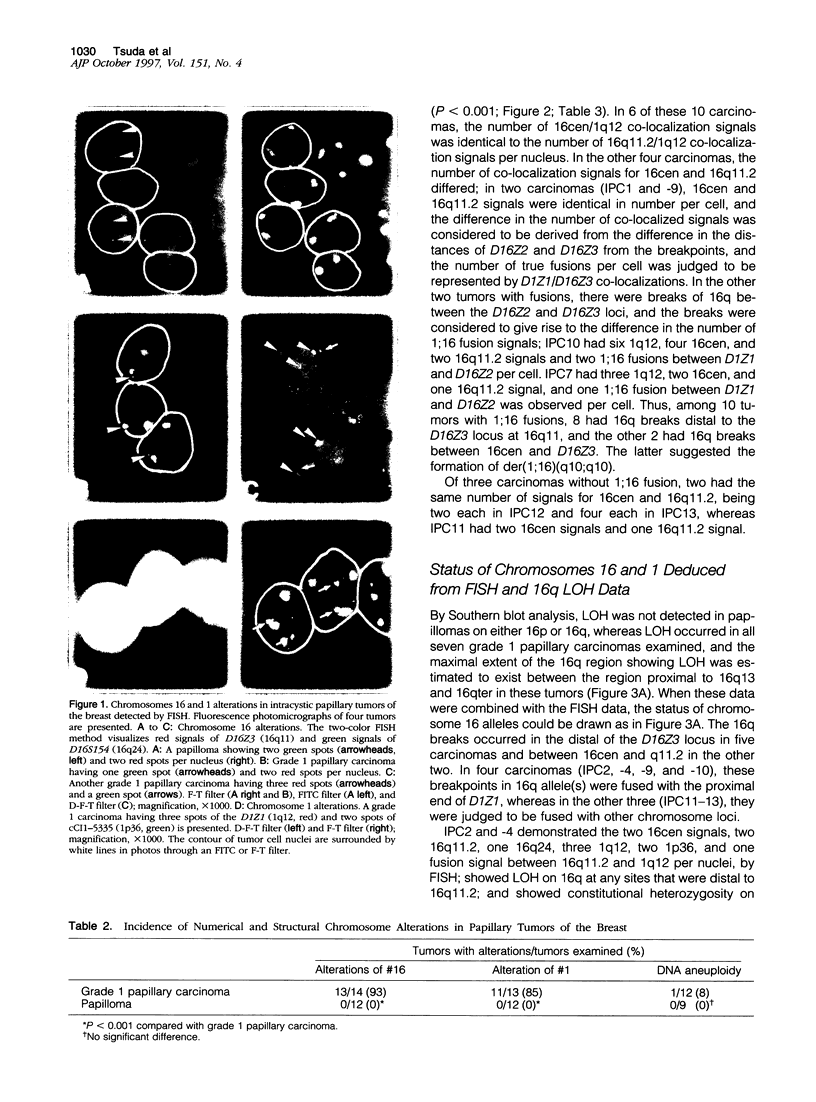
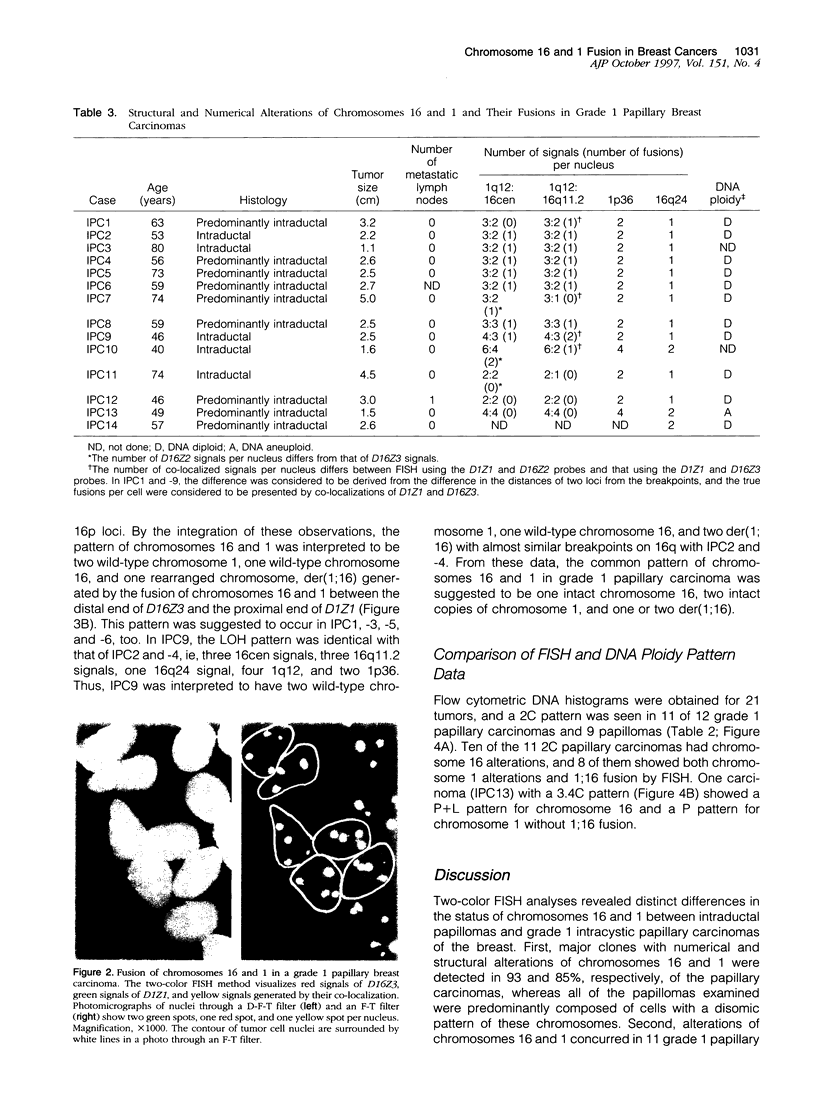
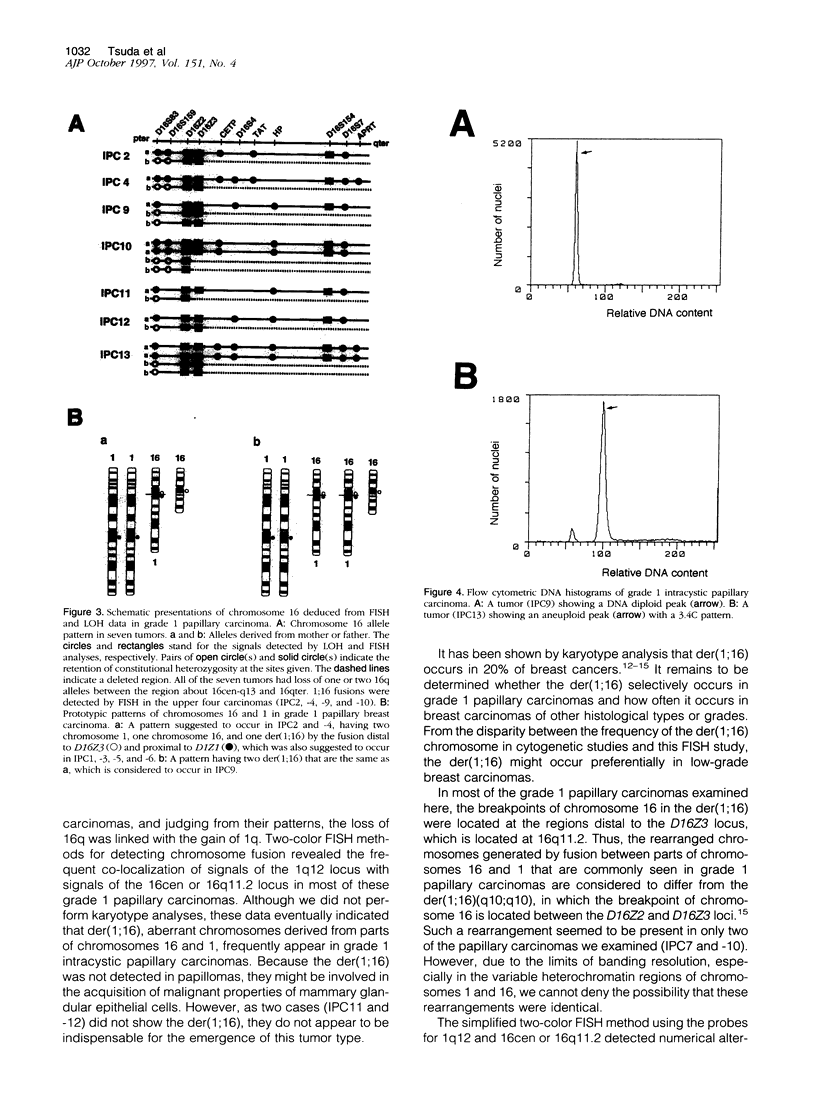

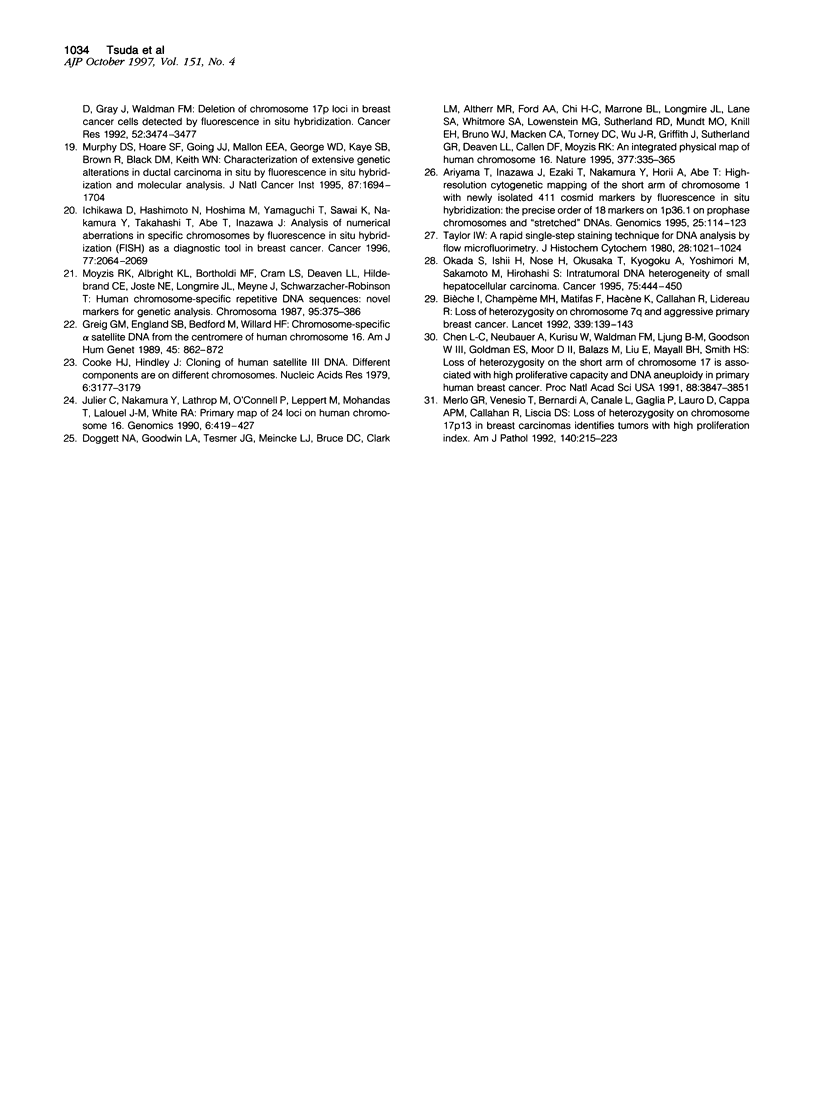
Images in this article
Selected References
These references are in PubMed. This may not be the complete list of references from this article.
- Ariyama T., Inazawa J., Ezaki T., Nakamura Y., Horii A., Abe T. High-resolution cytogenetic mapping of the short arm of chromosome 1 with newly isolated 411 cosmid markers by fluorescence in situ hybridization: the precise order of 18 markers on 1p36.1 on prophase chromosomes and "stretched" DNAs. Genomics. 1995 Jan 1;25(1):114–123. doi: 10.1016/0888-7543(95)80116-4. [DOI] [PubMed] [Google Scholar]
- Bièche I., Champème M. H., Matifas F., Hacène K., Callahan R., Lidereau R. Loss of heterozygosity on chromosome 7q and aggressive primary breast cancer. Lancet. 1992 Jan 18;339(8786):139–143. doi: 10.1016/0140-6736(92)90208-k. [DOI] [PubMed] [Google Scholar]
- Carter D., Orr S. L., Merino M. J. Intracystic papillary carcinoma of the breast. After mastectomy, radiotherapy or excisional biopsy alone. Cancer. 1983 Jul 1;52(1):14–19. doi: 10.1002/1097-0142(19830701)52:1<14::aid-cncr2820520104>3.0.co;2-n. [DOI] [PubMed] [Google Scholar]
- Chen L. C., Neubauer A., Kurisu W., Waldman F. M., Ljung B. M., Goodson W., 3rd, Goldman E. S., Moore D., 2nd, Balazs M., Liu E. Loss of heterozygosity on the short arm of chromosome 17 is associated with high proliferative capacity and DNA aneuploidy in primary human breast cancer. Proc Natl Acad Sci U S A. 1991 May 1;88(9):3847–3851. doi: 10.1073/pnas.88.9.3847. [DOI] [PMC free article] [PubMed] [Google Scholar]
- Cleton-Jansen A. M., Moerland E. W., Kuipers-Dijkshoorn N. J., Callen D. F., Sutherland G. R., Hansen B., Devilee P., Cornelisse C. J. At least two different regions are involved in allelic imbalance on chromosome arm 16q in breast cancer. Genes Chromosomes Cancer. 1994 Feb;9(2):101–107. doi: 10.1002/gcc.2870090205. [DOI] [PubMed] [Google Scholar]
- Cooke H. J., Hindley J. Cloning of human satellite III DNA: different components are on different chromosomes. Nucleic Acids Res. 1979 Jul 25;6(10):3177–3197. doi: 10.1093/nar/6.10.3177. [DOI] [PMC free article] [PubMed] [Google Scholar]
- Devilee P., Thierry R. F., Kievits T., Kolluri R., Hopman A. H., Willard H. F., Pearson P. L., Cornelisse C. J. Detection of chromosome aneuploidy in interphase nuclei from human primary breast tumors using chromosome-specific repetitive DNA probes. Cancer Res. 1988 Oct 15;48(20):5825–5830. [PubMed] [Google Scholar]
- Devilee P., van Vliet M., Bardoel A., Kievits T., Kuipers-Dijkshoorn N., Pearson P. L., Cornelisse C. J. Frequent somatic imbalance of marker alleles for chromosome 1 in human primary breast carcinoma. Cancer Res. 1991 Feb 1;51(3):1020–1025. [PubMed] [Google Scholar]
- Doggett N. A., Goodwin L. A., Tesmer J. G., Meincke L. J., Bruce D. C., Clark L. M., Altherr M. R., Ford A. A., Chi H. C., Marrone B. L. An integrated physical map of human chromosome 16. Nature. 1995 Sep 28;377(6547 Suppl):335–365. doi: 10.1038/377335a0. [DOI] [PubMed] [Google Scholar]
- Dutrillaux B., Gerbault-Seureau M., Remvikos Y., Zafrani B., Prieur M. Breast cancer genetic evolution: I. Data from cytogenetics and DNA content. Breast Cancer Res Treat. 1991 Nov;19(3):245–255. doi: 10.1007/BF01961161. [DOI] [PubMed] [Google Scholar]
- Dutrillaux B., Gerbault-Seureau M., Zafrani B. Characterization of chromosomal anomalies in human breast cancer. A comparison of 30 paradiploid cases with few chromosome changes. Cancer Genet Cytogenet. 1990 Oct 15;49(2):203–217. doi: 10.1016/0165-4608(90)90143-x. [DOI] [PubMed] [Google Scholar]
- Genuardi M., Tsihira H., Anderson D. E., Saunders G. F. Distal deletion of chromosome Ip in ductal carcinoma of the breast. Am J Hum Genet. 1989 Jul;45(1):73–82. [PMC free article] [PubMed] [Google Scholar]
- Greig G. M., England S. B., Bedford H. M., Willard H. F. Chromosome-specific alpha satellite DNA from the centromere of human chromosome 16. Am J Hum Genet. 1989 Dec;45(6):862–872. [PMC free article] [PubMed] [Google Scholar]
- Ichikawa D., Hashimoto N., Hoshima M., Yamaguchi T., Sawai K., Nakamura Y., Takahashi T., Abe T., Inazawa J. Analysis of numerical aberrations of specific chromosomes by fluorescent in situ hybridization as a diagnostic tool in breast cancer. Cancer. 1996 May 15;77(10):2064–2069. doi: 10.1002/(SICI)1097-0142(19960515)77:10<2064::AID-CNCR15>3.0.CO;2-T. [DOI] [PubMed] [Google Scholar]
- Julier C., Nakamura Y., Lathrop M., O'Connell P., Leppert M., Mohandas T., Lalouel J. M., White R. A primary map of 24 loci on human chromosome 16. Genomics. 1990 Mar;6(3):419–427. doi: 10.1016/0888-7543(90)90471-6. [DOI] [PubMed] [Google Scholar]
- KRAUS F. T., NEUBECKER R. D. The differential diagnosis of papillary tumors of the breast. Cancer. 1962 May-Jun;15:444–455. doi: 10.1002/1097-0142(196205/06)15:3<444::aid-cncr2820150303>3.0.co;2-0. [DOI] [PubMed] [Google Scholar]
- Kallioniemi O. P., Kallioniemi A., Kurisu W., Thor A., Chen L. C., Smith H. S., Waldman F. M., Pinkel D., Gray J. W. ERBB2 amplification in breast cancer analyzed by fluorescence in situ hybridization. Proc Natl Acad Sci U S A. 1992 Jun 15;89(12):5321–5325. doi: 10.1073/pnas.89.12.5321. [DOI] [PMC free article] [PubMed] [Google Scholar]
- Kokalj-Vokac N., Alemeida A., Gerbault-Seureau M., Malfoy B., Dutrillaux B. Two-color FISH characterization of i(1q) and der(1;16) in human breast cancer cells. Genes Chromosomes Cancer. 1993 May;7(1):8–14. doi: 10.1002/gcc.2870070103. [DOI] [PubMed] [Google Scholar]
- Matsumura K., Kallioniemi A., Kallioniemi O., Chen L., Smith H. S., Pinkel D., Gray J., Waldman F. M. Deletion of chromosome 17p loci in breast cancer cells detected by fluorescence in situ hybridization. Cancer Res. 1992 Jun 15;52(12):3474–3477. [PubMed] [Google Scholar]
- Merlo G. R., Venesio T., Bernardi A., Canale L., Gaglia P., Lauro D., Cappa A. P., Callahan R., Liscia D. S. Loss of heterozygosity on chromosome 17p13 in breast carcinomas identifies tumors with high proliferation index. Am J Pathol. 1992 Jan;140(1):215–223. [PMC free article] [PubMed] [Google Scholar]
- Moyzis R. K., Albright K. L., Bartholdi M. F., Cram L. S., Deaven L. L., Hildebrand C. E., Joste N. E., Longmire J. L., Meyne J., Schwarzacher-Robinson T. Human chromosome-specific repetitive DNA sequences: novel markers for genetic analysis. Chromosoma. 1987;95(6):375–386. doi: 10.1007/BF00333988. [DOI] [PubMed] [Google Scholar]
- Murphy D. S., Hoare S. F., Going J. J., Mallon E. E., George W. D., Kaye S. B., Brown R., Black D. M., Keith W. N. Characterization of extensive genetic alterations in ductal carcinoma in situ by fluorescence in situ hybridization and molecular analysis. J Natl Cancer Inst. 1995 Nov 15;87(22):1694–1704. doi: 10.1093/jnci/87.22.1694. [DOI] [PubMed] [Google Scholar]
- Okada S., Ishii H., Nose H., Okusaka T., Kyogoku A., Yoshimori M., Sakamoto M., Hirohashi S. Intratumoral DNA heterogeneity of small hepatocellular carcinoma. Cancer. 1995 Jan 15;75(2):444–450. doi: 10.1002/1097-0142(19950115)75:2<444::aid-cncr2820750206>3.0.co;2-p. [DOI] [PubMed] [Google Scholar]
- Pandis N., Heim S., Bardi G., Idvall I., Mandahl N., Mitelman F. Whole-arm t(1;16) and i(1q) as sole anomalies identify gain of 1q as a primary chromosomal abnormality in breast cancer. Genes Chromosomes Cancer. 1992 Oct;5(3):235–238. doi: 10.1002/gcc.2870050310. [DOI] [PubMed] [Google Scholar]
- Pandis N., Jin Y., Gorunova L., Petersson C., Bardi G., Idvall I., Johansson B., Ingvar C., Mandahl N., Mitelman F. Chromosome analysis of 97 primary breast carcinomas: identification of eight karyotypic subgroups. Genes Chromosomes Cancer. 1995 Mar;12(3):173–185. doi: 10.1002/gcc.2870120304. [DOI] [PubMed] [Google Scholar]
- Sato T., Akiyama F., Sakamoto G., Kasumi F., Nakamura Y. Accumulation of genetic alterations and progression of primary breast cancer. Cancer Res. 1991 Nov 1;51(21):5794–5799. [PubMed] [Google Scholar]
- Taylor I. W. A rapid single step staining technique for DNA analysis by flow microfluorimetry. J Histochem Cytochem. 1980 Sep;28(9):1021–1024. doi: 10.1177/28.9.6157714. [DOI] [PubMed] [Google Scholar]
- Tsuda H., Callen D. F., Fukutomi T., Nakamura Y., Hirohashi S. Allele loss on chromosome 16q24.2-qter occurs frequently in breast cancers irrespectively of differences in phenotype and extent of spread. Cancer Res. 1994 Jan 15;54(2):513–517. [PubMed] [Google Scholar]
- Tsuda H., Fukutomi T., Hirohashi S. Pattern of gene alterations in intraductal breast neoplasms associated with histological type and grade. Clin Cancer Res. 1995 Mar;1(3):261–267. [PubMed] [Google Scholar]
- Tsuda H., Uei Y., Fukutomi T., Hirohashi S. Different incidence of loss of heterozygosity on chromosome 16q between intraductal papilloma and intracystic papillary carcinoma of the breast. Jpn J Cancer Res. 1994 Oct;85(10):992–996. doi: 10.1111/j.1349-7006.1994.tb02895.x. [DOI] [PMC free article] [PubMed] [Google Scholar]



